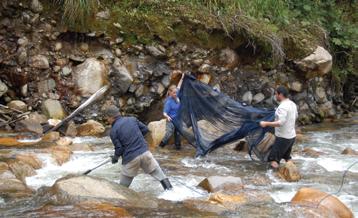
1 minute read
ENVIRONMENTAL RESILIENCE
8 9
One of the world’s foremost experts on seagrass ecosystems, James Fourqurean is a lead scientist in the International Blue Carbon Working Group, focused on carbon captured by oceans and coastal ecosystems. Fourqurean helped create a global partnership promoting the development of international conservation solutions.
Researcher Elizabeth Anderson leads work across the Amazon Basin to understand the dynamics of river flow and the human dependencies on river ecosystems. She’s principal investigator of the MacArthur Foundation-funded Ríos Vivos Andinos, or the Living Rivers Project, which seeks to improve river management, connecting experts on the rivers – the people who live, work and rely on them – to scientists, government authorities and local conservation partners.

Aquarius Reef Base lies 60 feet below the ocean’s surface. The world’s only undersea research laboratory enables research on coral reefs, ocean acidification, climate change, fisheries and overall ocean health. Outreach programs bring science live from Aquarius Reef Base to classrooms around the world.
The CREST Center for Aquatic Chemistry and Environment, an NSF Center of Research Excellence in Science and Technology, focuses on environmental contamination. Research buoys deployed around South Florida detect and investigate hazards, including the data collected during recent fish kills in Biscayne Bay.
More than 165 affiliated faculty work in the Institute of Environment, led by Todd Crowl. It is one of the largest, most impactful institutes of its kind in the world. FIU’s Miami location affords university researchers and students unparalleled access to some of the very oceans, waterways, coastlines and ecosystems they are working to save.
FIU is leading a team from eight universities as part of a $12.8 million National Science Foundation grant to design the world’s most powerful wind-water-wave testing facility. The facility will help scientists understand how increasingly stronger hurricanes are impacting coastal environments. When complete, the research laboratory will be capable of generating wind speeds of up to 200 miles per hour combined with a water basin to simulate storm surge and wave action.











